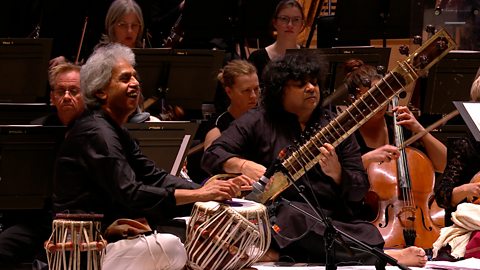Zakir Hussain's Triple Concerto for Tabla, Sitar and Bansuri

Zakir Hussain's Triple Concerto (Excerpt)
Watch the full performance on ÃÛÑ¿´«Ã½ iPlayer
Following the passing of the legendary tabla virtuoso Zakir Hussain in December 2024, the ÃÛÑ¿´«Ã½ SSO was honoured that Hussain’s brother, Fazal Qureshi, performed with the orchestra as tabla soloist in Hussain’s Triple Concerto in March 2025.
Watch Now on ÃÛÑ¿´«Ã½ iPlayer
It's a tale of love, tradition, and the transforming power of art.Zakir Hussain
Alongside conductor Alpesh Chauhan, Fazal Qureshi was joined on stage by soloists Niladri Kumar (sitar) and Rakesh Chaurasia (bansuri).
- Intoxicating… In this touching tribute to the late table player Zakir Hussain, his brother Fazal Qureshi and the ÃÛÑ¿´«Ã½ SSO did him proud” – The Scotsman
- “It is in the joyous finale that the fusion of Western and Indian melody is most complete. The mood is optimistic and playful, the melodic inventiveness irrepressible… What a super piece! The applause was tumultuous.” – Edinburgh Music Review

The Triple Concerto for tabla, sitar and bansuri is the second work commissioned by the Symphony Orchestra of India (SOI) from Zakir Hussain, the first being Peshkar, a concerto for tabla and orchestra, which was premiered in 2015. This was also the fourth composition by Zakir Hussain to be performed by the SOI – including the Triple Concerto for banjo, double bass and tabla, commissioned by the Nashville Symphony and performed by the SOI in 2013; and Ameen, Amen, Shanti, performed with singers Shankar Mahadevan, Harihdran and Kelley O’Connor, commissioned by the National Symphony Orchestra, Washington DC, and performed in Mumbai in 2020.
Speaking of his new Triple Concerto, Zakir Hussain wrote:
The idea is that there are two spirits or two beings or two kids who grew up together in the village. They became great friends, and they’re very happy in each other’s company. They do things together, move around together and study together … But then, when they get to a certain age, the village people step in. And they say: Now you can't do this, you can’t do that. You can’t go there. You can’t see him.
Why?
Well, because they don’t belong to our way of life.
The two principal characters – represented here by the sitar and bansuri – are in shock and they don’t understand why suddenly their friendship is now not supposed to be a friendship. There follows in their mind a confusion and then the pushback, and then finally the confrontation where they stand up for themselves.
A village elder – played by the tabla – intervenes and tries to make things right, and then eventually the matter is resolved in a more equitable and happy way.
